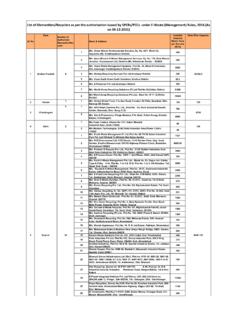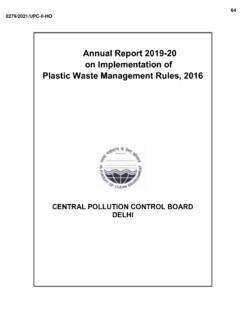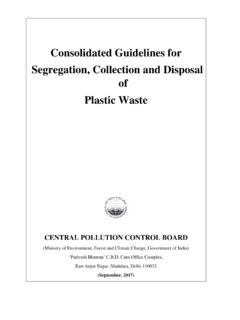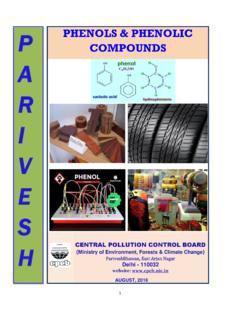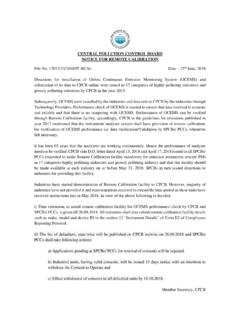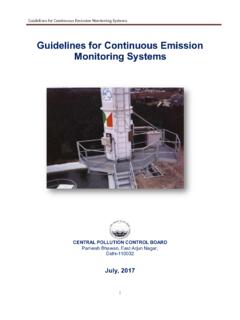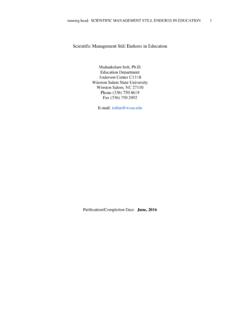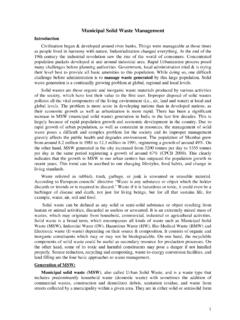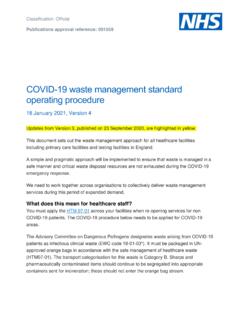Transcription of GUIDELINES FOR MANAGEMENT OF SANITARY WASTE
1 GUIDELINES FOR MANAGEMENT OF SANITARY WASTE As per Solid WASTE MANAGEMENT Rules, 2016 CENTRAL POLLUTION CONTROL BOARD Ministry of Environment & Forests, Govt. of India Parivesh Bhawan Cum-Office Complex, East Arjun Nagar, Shahdara, Delhi-110032 May 2018 Contents Introduction 1 Provisions of SANITARY Wastes in Solid WASTE MANAGEMENT Rules (SWM) Rules, 2016 1 Menstrual Hygiene MANAGEMENT National GUIDELINES (December 2015) 2 Provisions of Menstrual Hygiene MANAGEMENT (MHM)
2 In the SBM-G GUIDELINES , 2017 3 Current User Practices & Implementation Status Current practices Implementation status 5 5 5 WASTE MANAGEMENT Options 6 Role of Disposal of SANITARY WASTE at Customer/Producers/Private Agencies/SPCBs & PCCs/ULBs/ Villages/Panchayat/Local Levels i. At Consumer Level ii. At Producers Level iii. By Private Agencies iv. At SPCBs/PCCs Level v. At ULB/Local Level vi. At Villages/Panchayat Level 9 9 9 10 10 11 12 GUIDELINES on approval of SANITARY WASTE P a g e | - 1 - Introduction SANITARY WASTE disposal has become an increasing problem in India as the plastic used in disposable SANITARY napkins are not bio-degradable and lead to health and environmental hazards.
3 The impact is more pronounced because of the unorganized ways of municipal solid WASTE MANAGEMENT and poor community collection, disposal and transportation networks in the cities and villages. Further, one major issue of SANITARY WASTE has always been their categorization, , whether it is biomedical or plastic WASTE . Soiled napkins, diapers, condoms, tampons and blood-soaked cotton, which are household WASTE according to the Solid WASTE MANAGEMENT (SWM) Rules, 2016, are being disposed after segregation into biodegradable and non-biodegradable components.
4 However, the Bio-Medical WASTE MANAGEMENT Rules, 2016 indicate that items contaminated with blood and body fluids, including cotton, dressings, soiled plaster casts, lines and bedding, are bio-medical WASTE and should be incinerated, autoclaved or microwaved to destroy pathogens. The lack of concern for SANITARY WASTE MANAGEMENT in our country is reflected in the fact that there is no reliable statistics on the subject. Due to the lack of segregation of WASTE , there is hardly any documentation in this area, so through instructions for handling and MANAGEMENT of SANITARY WASTE are essential.
5 As per the study conducted in 2011, titled SANITARY Protection: Every woman s health right estimated that only 12% of the 335 million menstruating women have access to disposable SANITARY napkins. Environment portal Down to Earth estimated that 432 million pads are disposed every month. Provisions of SANITARY Wastes in Solid WASTE MANAGEMENT Rules (SWM), 2016 According to the provision of 3(46) of Solid WASTE MANAGEMENT Rules, 2016, solid WASTE was categorized as follows.
6 Solid or semi-solid domestic WASTE , SANITARY WASTE , commercial WASTE , institutional WASTE , catering and market WASTE and other non-residential wastes, street sweepings, silt removed or collected from the surface drains, horticulture WASTE , agriculture and dairy WASTE , treated bio-medical WASTE excluding industrial WASTE , bio-medical WASTE and e- WASTE , battery WASTE , radio-active WASTE generated in the area under the local authorities. Further, as per the provision of 14(i) of SWM Rules, 2016, Central Pollution Control Board has a provision to publish GUIDELINES , from time to time, on environmental aspects of processing and disposal of solid WASTE to enable local bodies to comply with the provisions of these rules.
7 Therefore, in exercise of the power conferred by section 14(i) of the Solid WASTE MANAGEMENT , Rules, 2016 and the objections and suggestions received from the public, the Government of India through CPCB has framed the GUIDELINES on SANITARY WASTE MANAGEMENT to ensure proper disposal of SANITARY WASTE . Most of the existing SANITARY WASTE MANAGEMENT facilities are practicing under SWM Rules, 2016, which are as follows: Rule 3(19), dry WASTE means WASTE other than bio-degradable WASTE and inert street sweepings and includes recyclable and non-recyclable WASTE , combustible WASTE and SANITARY napkin and diapers, etc.
8 GUIDELINES on approval of SANITARY WASTE P a g e | - 2 - Rule 3(41), SANITARY WASTE means wastes comprising of used diapers, SANITARY towels or napkins, tampons, condoms, incontinence sheets and any other similar WASTE ; Rule (4)(b), states that wrap securely the used SANITARY WASTE like diapers, SANITARY pads etc., in the pouches provided by the manufacturers or brand owners of these products or in a suitable wrapping material as instructed by the local authorities and shall place the same in the bin meant for dry WASTE or non- bio-degradable WASTE .
9 Rule 15(zg) (iv) & (vi), stated that the Local Authority and Nagar Panchayat shall create public awareness through information, education and communication campaign and educate the WASTE generators on wrapping used SANITARY WASTE securely as and when generated in the pouches provided by the brand owners or a suitable wrapping as prescribed by the local body and place the same in the bin meant for non-biodegradable WASTE . The Local Authority and Nagar Panchayat shall also educate public on segregation of SANITARY WASTE at source.
10 As per Rule 17, duty of manufacturer or brand owners of disposable products and SANITARY napkins and diapers are given below: (i) All manufacturers of disposable products such as tin, glass, plastics packaging, etc., or brand owners who introduce such products in the market shall provide necessary financial assistance to local authorities for establishment of WASTE MANAGEMENT system. (ii) All such brand owners who sell or market their products in such packaging material which are non-biodegradable shall put in place a system to collect back the packaging WASTE generated due to their production.

